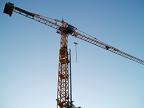Information contained in this publication is intended for informational purposes only and does not constitute legal advice or opinion, nor is it a substitute for the professional judgment of an attorney.
 The Occupational Safety and Health Administration (OSHA) has issued new regulations (pdf) addressing the safety of cranes and derricks in the construction industry. The rule updates and specifies industry work practices regarding the use of cranes and derricks, and also “addresses advances in the designs of cranes and derricks, related hazards, and the qualifications of employees needed to operate them safely.” According to an OSHA press release, approximately 267,000 construction, crane rental and crane certification establishments employing about 4.8 million workers will be affected by the rule.
The Occupational Safety and Health Administration (OSHA) has issued new regulations (pdf) addressing the safety of cranes and derricks in the construction industry. The rule updates and specifies industry work practices regarding the use of cranes and derricks, and also “addresses advances in the designs of cranes and derricks, related hazards, and the qualifications of employees needed to operate them safely.” According to an OSHA press release, approximately 267,000 construction, crane rental and crane certification establishments employing about 4.8 million workers will be affected by the rule.
The rule, which has been in the works for a number of years, mandates that employers in the construction industry take the following steps:
- Assess whether the ground is sufficient to support the anticipated weight of hoisting equipment and associated loads;
- Assess hazards within the work zone that would affect the safe operation of hoisting equipment, such as those of power lines and objects or personnel that would be within the work zone or swing radius of the hoisting equipment; and
- Ensure that the equipment is in safe operating condition via required inspections and mandate that employees in the work zone are trained to recognize hazards associated with the use of the equipment and any related duties that they are assigned to perform.
As the agency explains, the rule aims to prevent electrocution, crushed-by/struck-by hazards during assembly/disassembly, collapse and overturn, among other types of lethal injuries related to crane and derrick operations. According to a fact sheet, the significant requirements in this new rule include: a pre-erection inspection of tower crane parts; use of synthetic slings in accordance with the manufacturer's instructions during assembly/disassembly work; assessment of ground conditions; qualification or certification of crane operators; and procedures for working in the vicinity of power lines. The rule also provides a functional description and a list of examples of equipment covered by the rule. Other changes of note, as explained in the fact sheet, include the following:
- Employers must comply with local and state operator licensing requirements which meet the minimum criteria specified in § 1926.1427.
- Employers must pay for certification or qualification of their currently uncertified or unqualified operators.
- Written certification tests may be administered in any language understood by the operator candidate.
- When employers with employees qualified for power transmission and distribution are working in accordance with the power transmission and distribution standard (§ 1910.269), that employer will be considered in compliance with this final rule's requirements for working around power lines.
- Employers must use a qualified rigger for rigging operations during assembly/disassembly.
- Employers must perform a pre-erection inspection of tower cranes.
This rule will take effect 90 days after publication in the Federal Register, which is scheduled for August 9, 2010. Certain provisions have delayed effective dates ranging from 1 to 4 years. The rule estimates that the total annualized costs of implementing these new requirements will amount to $154.1 million.
To help employers understand these new requirements, OSHA hosted a web chat on Wednesday, July 28. As explained during the chat, the agency will also be developing a compliance directive in a series of guidance and outreach documents that will be available before the standard goes into effect. Other clarifications made during the chat include the following:
- The new regulations apply to the construction industry only. However, if an employer in the general industry performs construction-related work, it will be covered by the regulations.
- Crane operators have up to four years to obtain the necessary certification, unless the employer operates in a city or state with local licensing requirements.
- Once the OSHA standard is issued, states that maintain their own safety and health plans will have six months to adopt the new standard or develop their own standard that is at least as effective.
- This new rule will affect most types of cranes and derricks engaged in construction activity, as outlined in section 1926.1400. Those types of equipment not specified in this section are not covered by the rule.
- With respect to general contractors that do not own cranes, the OSHA staff explained that the new rule may require general contractors to share information and receive information regarding ground conditions.
- Some changes that were included in the final rule that were not seen in the proposed rule include:
- Employers that have employees who are qualified in subpart V work may comply with 1910.269 of the general industry standard;
- All utility pole work performed with digger derricks are excluded;
- Employers must comply with manufacturer’s recommendations for the use of synthetic slings;
- Forklifts are covered by the final rule when they are configured like a crane; and
- OSHA provided clarification in the preamble to address when knuckleboom cranes are covered by the standard during material delivery.

